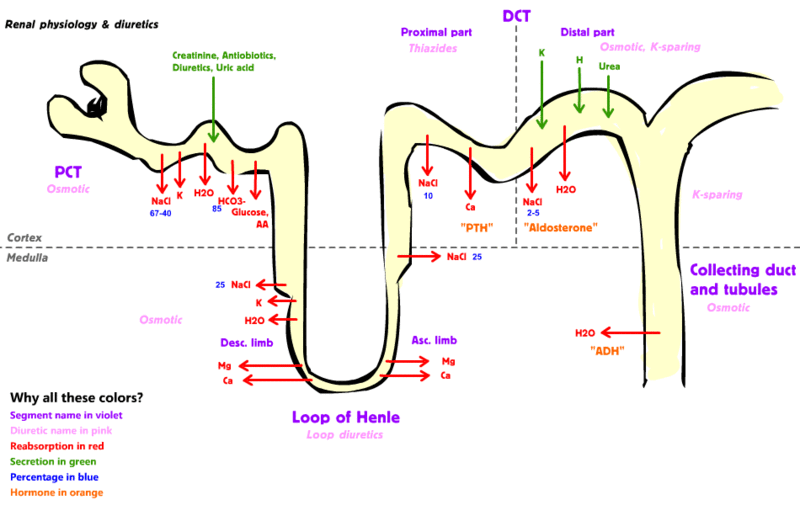Diuretic

|
WikiDoc Resources for Diuretic |
|
Articles |
|---|
|
Most recent articles on Diuretic |
|
Media |
|
Evidence Based Medicine |
|
Clinical Trials |
|
Ongoing Trials on Diuretic at Clinical Trials.gov Clinical Trials on Diuretic at Google
|
|
Guidelines / Policies / Govt |
|
US National Guidelines Clearinghouse on Diuretic
|
|
Books |
|
News |
|
Commentary |
|
Definitions |
|
Patient Resources / Community |
|
Directions to Hospitals Treating Diuretic Risk calculators and risk factors for Diuretic
|
|
Healthcare Provider Resources |
|
Causes & Risk Factors for Diuretic |
|
Continuing Medical Education (CME) |
|
International |
|
|
|
Business |
|
Experimental / Informatics |
Editor-In-Chief: C. Michael Gibson, M.S., M.D. [1]
Overview
A diuretic is any drug that elevates the rate of bodily urine excretion (diuresis). There are several categories of diuretics. All diuretics increase the excretion of water from the body, although each class of diuretic does so in a distinct way.
High ceiling loop diuretics
High ceiling diuretics are diuretics that may cause a substantial diuresis - up to 20%[1] of the filtered load of NaCl and water. This is huge, compared to that normal renal sodium reabsorption leaves only ~0.4% of filtered sodium in the urine.
Loop diuretics have this ability, and is therefore often synonymous with high ceiling diuretics. Loop diuretics, such as furosemide, inhibit the body's ability to reabsorb sodium at the ascending loop in the kidney which leads to a retention of water in the urine as water normally follows sodium back into the extracellular fluid (ECF). Other examples of high ceiling loop diuretics include ethacrynic acid, torsemide and bumetanide.
Thiazides
Drugs such as hydrochlorothiazide act on the distal tubule and inhibit the Na-Cl symport leading to a retention of water in the urine as water normally follows penetrating solutes.
Potassium-sparing diuretics
These are diuretics which do not promote the secretion of potassium into the urine; thus, potassium is spared and not lost as much as in other diuretics. Such drugs include spironolactone which is a competitive antagonists of aldosterone. Aldosterone normally adds sodium channels in the principal cells of the collecting duct and late distal tubule of the nephron. Spironolactone prevents aldosterone from entering the principal cells, preventing sodium reabsorption. Other examples of potassium-sparing diuretics are amiloride and triamterene. These drugs bind to the sodium channels of the principal cells, inhibiting an aldosterone-induced increase in sodium reabsorption.
Osmotic diuretics
Compounds such as mannitol are filtered in the glomerulus, but cannot be reabsorbed. Their presence leads to an increase in the osmolarity of the filtrate. To maintain osmotic balance, water is retained in the urine.
High Blood Glucose
Glucose, like mannitol, is a sugar that can behave as an osmotic diuretic. Unlike mannitol, glucose is commonly found in the blood. However, in certain conditions such as diabetes mellitus, the concentration of glucose in the blood exceeds the maximum resorption capacity of the kidney. When this happens, glucose remains in the filtrate, leading to the osmotic retention of water in the urine. Use of some drugs, especially stimulants may also increase blood glucose and thus increase urination.
Uses
In medicine, diuretics are used to treat heart failure, liver cirrhosis, hypertension and certain kidney diseases. Some diuretics, such as acetazolamide, help to make the urine more alkaline and are helpful in increasing excretion of substances such as aspirin in cases of overdose or poisoning. Diuretics are often abused by sufferers of eating disorders, especially bulimics, in attempts at weight loss.
The antihypertensive actions of some diuretics (thiazides and loop diuretics in particular) are independent of their diuretic effect. That is, the reduction in blood pressure is not due to decreased blood volume resulting from increased urine production, but occurs through other mechanisms and at lower doses than that required to produce diuresis. Indapamide was specifically designed with this in mind, and has a larger therapeutic window for hypertension (without pronounced diuresis) than most other diuretics.
Mechanism of action
Classification of common diuretics and their mechanisms of action:
Chemically, diuretics are a diverse group of compounds that either stimulate or inhibit various hormones that naturally occur in the body to regulate urine production by the kidneys. Herbal medications are not inherently diuretics. They are more correctly called aquaretics.
Adverse effects
The main adverse effects of diuretics are hypovolemia, hypokalemia, hyperkalemia, hyponatremia, metabolic alkalosis, metabolic acidosis and hyperuricemia [2]. Each are at risk of certain types of diuretics and present with different symptoms.
| Adverse effect | Diuretics | Symptoms |
|---|---|---|
| Hypovolemia | ||
| hypokalemia | ||
| Hyperkalemia | ||
| hyponatermia | ||
| metabolic alkalosis |
| |
| metabolic acidosis |
| |
| hypercalcemia | ||
| hyperuricemia |
References
- ↑ Drug Monitor - Diuretics
- ↑ 2.00 2.01 2.02 2.03 2.04 2.05 2.06 2.07 2.08 2.09 2.10 2.11 2.12 2.13 2.14 2.15 2.16 2.17 2.18 2.19 2.20 2.21 2.22 2.23 2.24 2.25 2.26 2.27 2.28 2.29 2.30 2.31 2.32 2.33 2.34 2.35 2.36 2.37 2.38 2.39 2.40 2.41 2.42 2.43 Walter F., PhD. Boron. Medical Physiology: A Cellular And Molecular Approaoch. Elsevier/Saunders. ISBN 1-4160-2328-3. Page 875
Template:Major Drug Groups Template:PAH rx
de:Diuretikum hr:Diuretici it:Diuretici he:משתן nl:Diureticum no:Diuretikum nn:Urindrivande lækjemiddel simple:Diuretic sl:Diuretik sr:Диуретик fi:Diureetti sv:Vätskedrivande medel th:ยาขับปัสสาวะ